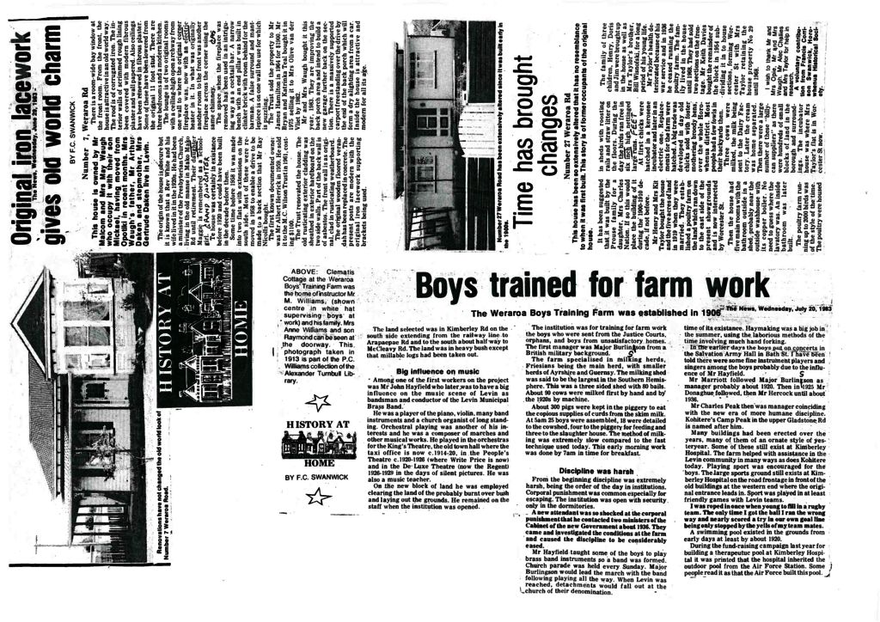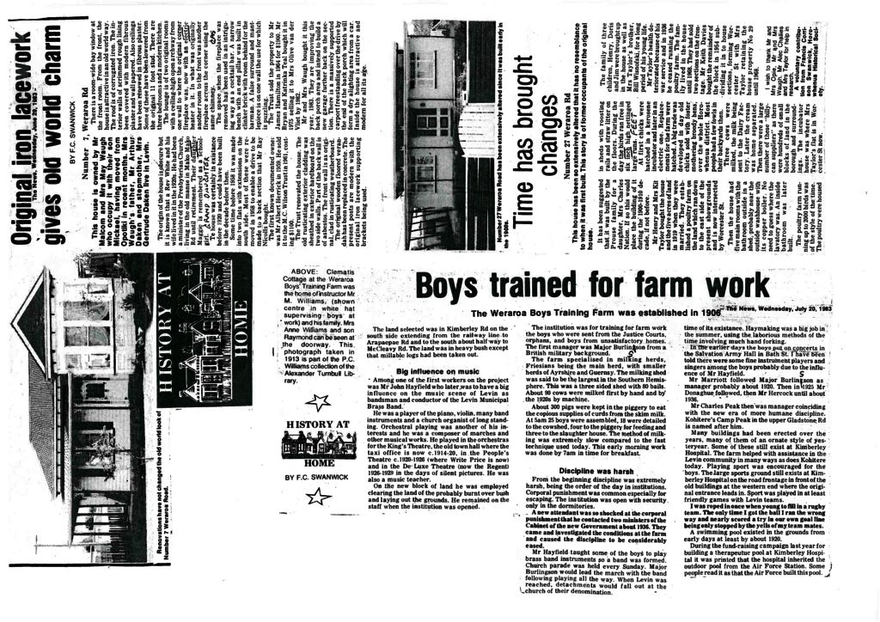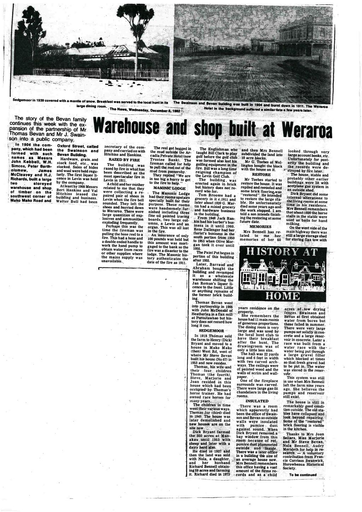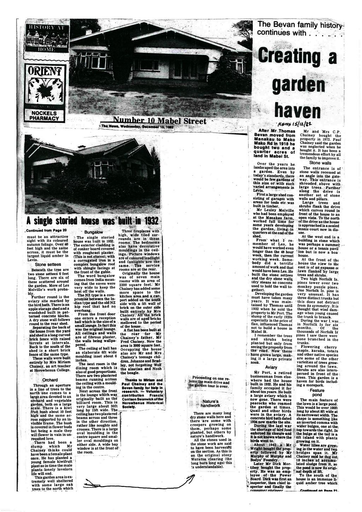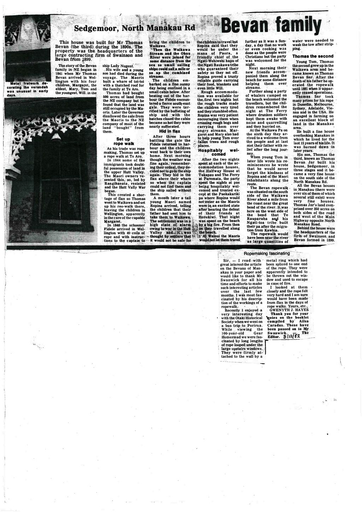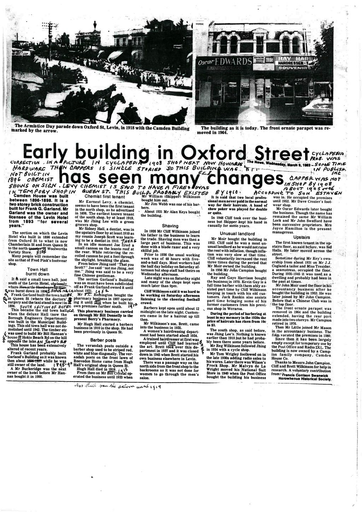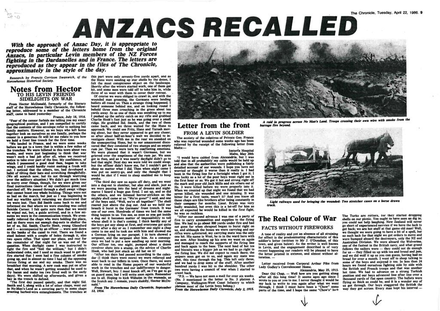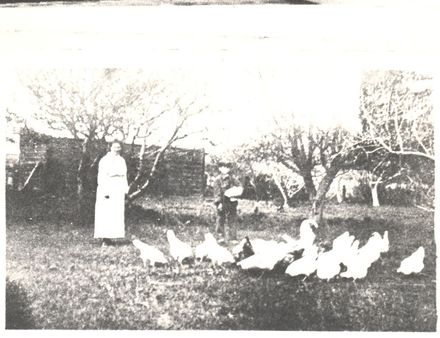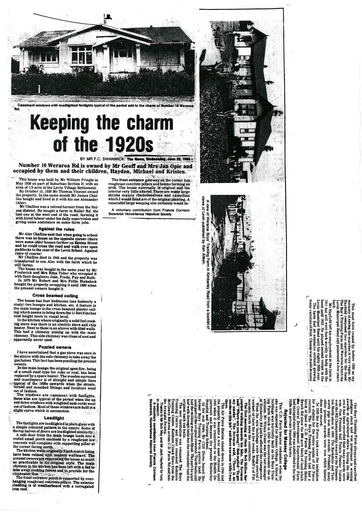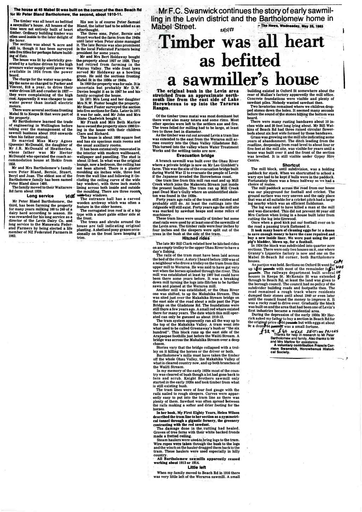Boys trained for farm work
- Description
The land selected was in Kimberley Rd on the south side extending from the railway line to Arapaepae Rd and to the south about half way to McLeavey Rd. The land was in heavy bush, except that millable logs had been taken out.
Big influence on Music
Among one of the first workers on the project was Mr John Hayfield who later was to have a big influence on the music scene of Levin as bandsman and conductor of the Levin Municipal Brass Band.
He was a player of the piano, violin, many band instruments and a church organist of long standing. Orchestral playing was another of his interests and he was a composer of marches and other musical works. He played in the orchestras for the King’s Theatre, the old town hall where the taxi office is now c.1914-20, in the People’s Theatre c.1920-1926 (where Write Price is now) and in the De Luxe Theatre (now the Regent) 1926-1929 in the days of silent pictures. He was also a music teacher.
On the new block of land he was employed clearing the land of the probably burnt over bush and laying out the grounds. He remained on the staff when the institution was opened.
The institution was for training for farm work; the boys were sent from the Justice Courts, orphans and from unsatisfactory homes. The first manager was Major Burlinson from a British military background.
The farm specialised in milking herds, Friesians being the main herd, with smaller herds of Ayrshire and Guernsey. The milking shed was said to be the largest in the Southern Hemisphere. This was a three sided shed with 80 bails. About 90 cows were milked first by hand and by the 1920s by machine.
About 300 pigs were kept in the piggery to eat the copious supplies of curds from the skim milk. At 5am 25 boys were assembled, 18 were detailed to the cowshed, four to the piggery for feeding and three to the slaughter house. The method of milking was extremely slow compared to the fast technique used today. This early morning work was done by 7am in time for breakfast.
Discipline was harsh
From the beginning discipline was extremely harsh, being the order of the day in institutions. Corporal punishment was common, especially for escaping. The institution was open with security only in the dormitories.
A new attendant was so shocked at the corporal punishment that he contacted two ministers of the Cabinet of the new Government about 1936. They came and investigated the conditions at the farm and caused the discipline to be considerably eased.
Mr Hayfield taught some of the boys to play brass band instruments so a band was formed. Church parade was held every Sunday. Major Burlinson would lead the march with the band following playing all the way. When Levin was reached, detachments would fall out at the church of their denomination.
In the earlier days the boys put on concerts in the Salvation Army Hall in Bath St. I have been told there were some fine instrument players and singers among the boys probably due to the influence of Mr Hayfield.
Mr Marriott followed Major Burlinson as manager probably about 1920. Then in 1925 Mr Donahugue followed, then Mr Hercock until about 1936.
Mr Charles Peak then was manager coinciding with the new era of more humane discipline. Kohitere’s Camp Peak in the upper Gladstone Rd is named after him.
Many buildings had been erected over the years, many of them of an ornate style of yesteryear. Some of these still exist at Kimberley Hospital. The farm helped with assistance in the Levin community in many ways as does Kohitere today. Playing sport was encouraged for the boys. The large sports ground still exists at Kimberley Hospital on the road frontage in front of the old buildings at the western end where the original entrance leads in. Sport was played in at least friendly games with Levin teams.
Left: Clematis Cottage at the Weraroa Boys Training Farm was the home of instructor Mr M. Williams, (shown centre in white hat supervising boys at work) and his family. Mrs Anne Williams and son Raymond can be seen at the doorway. This photograph taken in 1913 is part of the P.C.Williams collection of the Alexander Turnbull Library.
I was roped in once when young to fill in a rugby team. The only time I got the ball I ran the wrong way and nearly scored a try in our own goal line being only stopped by the yells of my team mates.
A swimming pool existed in the grounds from early days at least by about 1920.
During the fund-raising campaign last year for building a therapeutic pool at Kimberley Hospital it was printed that the hospital inherited the outdoor pool from the Air Force Station. Some people read it as the Air Force built this pool.
Identification
- Date
- July 20, 1983
Taxonomy
- Community Tags

